

English Dissenters 3/3. English Dissenters were Christians who separated from the Church of England in the 16th, 17th and 18th centuries.[1] They originally agitated for a wide-reaching Protestant Reformation of the Established Church, and triumphed briefly under Oliver Cromwell.

Ranters. The Ranters were a sect in the time of the English Commonwealth (1649–1660) who were regarded as heretical by the established Church of that period.
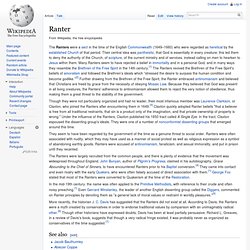
Their central idea was pantheistic, that God is essentially in every creature; this led them to deny the authority of the Church, of scripture, of the current ministry and of services, instead calling on men to hearken to Jesus within them. Many Ranters seem to have rejected a belief in immortality and in a personal God, and in many ways they resemble the Brethren of the Free Spirit in the 14th century.[1] The Ranters revived the Brethren of the Free Spirit's beliefs of amoralism and followed the Brethren's ideals which “stressed the desire to surpass the human condition and become godlike.”[2] Further drawing from the Brethren of the Free Spirit, the Ranter embraced antinomianism and believed that Christians are freed by grace from the necessity of obeying Mosaic Law.
More recently, the historian J. C. See also[edit] English Dissenters 2/3. Sabbatarians. English Dissenters were Christians who separated from the Church of England in the 16th, 17th and 18th centuries.[1] They originally agitated for a wide-reaching Protestant Reformation of the Established Church, and triumphed briefly under Oliver Cromwell.
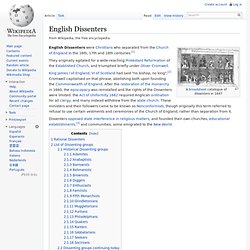
British Anabaptism. During the late Tudor period (1530–1603) many English dissenting sects were lumped together under the term Anabaptism (even William Tyndale, the Bible translator, was charged with Anabaptist heresy), so it is hard to know about the groups of Anabaptists present in the British realms.[1] History[edit] Dutch and Flemish Anabaptists founded congregations in England as early as 1534, but for the next ten years they were heavily persecuted; large numbers of foreign Anabaptists were executed or burned at the stake.
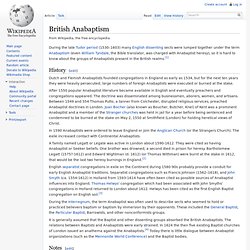
After 1550 popular Anabaptist literature became available in English and eventually preachers and congregations appeared. Barrowists. Henry Barrowe (or Barrow) (c. 1550 – 6 April 1593) was an English Separatist Puritan, executed for his views.

Life[edit] Greenwood was imprisoned in The Clink, and Barrowe came from the country to visit him. On 19 November 1586 he was detained by the gaoler and brought before Archbishop John Whitgift.[3] He insisted on the illegality of this arrest, refused either to take the ex officio oath or to give bail for future appearance, and was committed to the Gatehouse Prison.[1] After nearly six months detention and several irregular examinations before the high commissioners, he and Greenwood were formally indicted (May 1587) for recusancy under an act originally directed against Roman Catholics.
They were ordered to find heavy bail for conformity, and to remain in the Fleet Prison until it was forthcoming. He was subjected to several more examinations, once before the Privy Council at Whitehall on 18 March 1588, as a result of petition to the Queen. Views[edit] Fifth Monarchists. Title page of A Brief description of the Fifth Monarchy or Kingdome (1653) by William Aspinwall.

Overview[edit] English Commonwealth and Protectorate[edit] A number of Fifth Monarchists took a leading part in the events of the time. Thomas Harrison and John Carew were Commissioners (judges) at the trial of Charles I and signed the death warrant. Following Charles' death, Oliver Cromwell set up the Commonwealth as a more pure form of government to replace the existing monarchy.
Grindletonians. Coordinates: The Grindletonians were a Puritan sect that arose in the small community of Grindleton in Lancashire, England, around 1610.

The sect remained active in the north of England until the 1660s. The most notable leader was Roger Brearley (or Brereley). Grindletonian beliefs were Antinomian. History[edit] Grindleton in May 2007 Brearley was brought before the York High Commission in October 1616 to answer charges that he was a radical nonconformist, that he relied on the motion of the spirit and that he thought that all doubt about their salvation would be removed from believers. Beliefs[edit] Some of Brearley's ideas would have been drawn from the Theologia Germanica. Behmenism. Definition[edit] Modern use[edit] References[edit] Jump up ^ An early English language example is provided in Anderdon, John.

"One blow at Babel, in those of the People called Behmenites, Whose foundation is...upon their own cardinal conception, begotten in their imaginations upon Jacob Behmen's writings. " London: 1662.Jump up ^ Hutin, Serge. Muggletonianism. The Muggletonians, named after Lodowicke Muggleton, were a small Protestant Christian movement which began in 1651 when two London tailors announced they were the last prophets foretold in the biblical Book of Revelation.
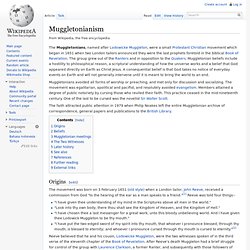
The group grew out of the Ranters and in opposition to the Quakers. Muggletonian beliefs include a hostility to philosophical reason, a scriptural understanding of how the universe works and a belief that God appeared directly on Earth as Christ Jesus. A consequential belief is that God takes no notice of everyday events on Earth and will not generally intervene until it is meant to bring the world to an end. Muggletonians avoided all forms of worship or preaching, and met only for discussion and socializing. Seekers. The Seekers, or Legatine-Arians as they were sometimes known, were a Protestant dissenting group that emerged around the 1620s, probably inspired by the preaching of three brothers – Walter, Thomas, and Bartholomew Legate.
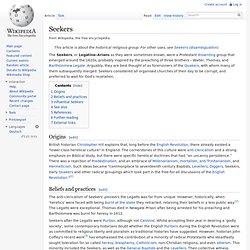
Arguably, they are best thought of as forerunners of the Quakers, with whom many of them subsequently merged. Seekers considered all organised churches of their day to be corrupt, and preferred to wait for God's revelation. Origins[edit] English Dissenters 1/3. Brownist. Origins[edit] There had been early advocates of a congregational form of organization for the Church of England, in the time of Henry VIII.
When, on the re-establishment of the Anglican Church, after the Catholic Mary's reign, it became clear that the English government had other plans, they looked towards setting up a separate church. Browne's leadership[edit] Browne became a Lecturer at St Mary's Church, Islington, where his dissident preaching against the doctrines and disciplines of the Church of England began to attract attention.[1] During 1578, Browne returned to Cambridge University and came under the influence of Richard Greenham, puritan rector of Dry Drayton.
He encouraged Browne to complete his ordination and serve at a parish church. Puritan. The Puritans were a group of English Protestants in the 16th and 17th centuries, including, but not limited to, English Calvinists. Puritanism in this sense was founded by some Marian exiles from the clergy shortly after the accession of Elizabeth I of England in 1558, as an activist movement within the Church of England. Socinianism. Restorationism. Efforts to restore an earlier, purer form of Christianity are often a response to denominationalism. Diggers. The Diggers were a group of Protestant English agrarian socialists,[2] begun by Gerrard Winstanley as True Levellers in 1649, who became known as Diggers, because of their attempts to farm on common land. Their original name came from their belief in economic equality based upon a specific passage in the Book of Acts.[3][4] The Diggers tried (by "leveling" real property) to reform the existing social order with an agrarian lifestyle based on their ideas for the creation of small egalitarian rural communities.
They were one of a number of nonconformist dissenting groups that emerged around this time. Historical background[edit] Government through the King's Privy Council was replaced with a new body called the Council of State, which due to fundamental disagreements within a weakened Parliament was dominated by the Army. Many people were active in politics, suggesting alternative forms of government to replace the old order. Philadelphians. In later years, although no longer officially a functioning group, many of the Philadelphian Society's views and writings, particularly those by Jane Leade, remained influential among certain groups of Behmenists, Pietists, Radical Pietists, Christian mystics, and Esoteric Christians, such as the Society of the Woman in the Wilderness (led by Johannes Kelpius), the Ephrata Cloister, and the Harmony Society, among others.
Notable Philadelphians and others associated with them[edit] References[edit] Jump up ^ Hirst, Julie. Jane Leade: Biography of a Seventeenth-Century Mystic. Aldershot: Ashgate, 2005. p. 27. Adamites. Adamites being rounded up by men with guns. Familist. The Family of Love or Familists (English term) was a mystic religious sect known as the Familia Caritatis (Hus der Lieften; Huis der Liefde; Haus der Liebe; Family of Love), founded in the sixteenth century by Henry Nicholis, also known as Niclaes.